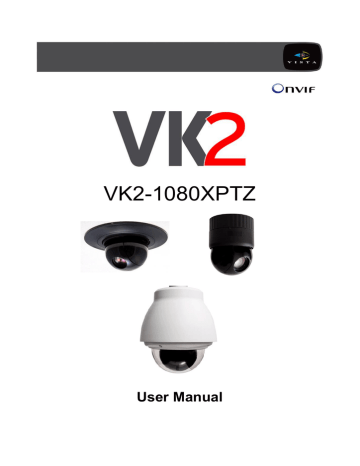advertisement

3.5.4 Audio
Refer to “3.5.1 Basic Configuration > Audio” for more details.
3.5.5 Event
1) Event In
On Boot
This is used to trigger the event every time the VK2-1080XPTZ is started. Select
“Enable” to activate the event.
VK2-1080XPTZ User Manual V1.0
36
Alarm In
This page allows you to configure the input supported by the camera. The Port can be given as Normally Open or Normally Close state, and their Normal state can be configured.
An input will be inactive as long as its Normal state equals its Current state. The 2 options for Normal state are NO (Normally Open) and NC (Normally Close). The input is activated when the Current state changes so that it no longer equals the Normal state.
Alarm In Port 1 Setting:
Click the Enable alarm in port 1 checkbox to enable the Alarm In port 1.
- Type: The default setting is NO.
* NO: Normally Open
As an example, if the Normal state for a push button connected to an input is Open circuit, this means that as long as the button is not pushed (and the Current state remains as Open circuit), the state will be inactive.
* NC: Normally Close
When the button is pushed, the circuit is grounded, the input's state changes to
Grounded circuit and the input will no longer be in its normal state - it will have become active.
An input on the camera has an Open circuit when disconnected or when there is a voltage.
- Dwell time: The default setting is 60 seconds. Dwell time means how long time the alarm input signal is held on as an input signaling source.
Click the Save button to save the settings, or click the Reset button to clear all of the information you entered without saving it.
VK2-1080XPTZ User Manual V1.0
37
Manual Trigger
This option makes use of the Manual Trigger button provided on the Live View page, which is used to start or stop the event type manually. Alternatively, the event can be triggered via the product's API (Application Programming Interface).
Motion
Motion detection is used to generate an alarm whenever movement occurs (or stops) in the video image. A total of 8 Motion and/or Mask windows can be created and configured.
Motion is detected in defined Motion windows, which are placed in the video image to target specific areas. Movement in the areas outside the motion windows will be ignored. If part of a motion window needs to be masked, this can be configured in a Mask window.
VK2-1080XPTZ User Manual V1.0
38
Pre-Viewer: Motion detection windows are configured by Motion or Mask windows. Each window can be selected by clicking with the mouse. It is also possible to resize, delete or
move the window, by selecting the appropriate window at the mouse menu on the video screen.
To create a motion or mask window, follow these steps:
1. Click the right button of mouse to see the mouse menu.
2. Select New Motion (or New Mask) from the mouse menu.
3. Click and drag mouse to designate a motion area.
Motion Detection Setting: The behavior for each window is defined by adjusting the
Threshold and Sensitivity, as described below.
A motion index is a set of parameters describing Window Name, Type, Threshold and Dwell
Time. Window Types is one of Motion and Mask windows.
- Threshold: Sets up the threshold for the motion detection.
- Dwell Time: Sets the hold time an event lasts for the specified hold time from the point of detection of a motion.
You can also modify or delete a motion index. Select an index and then, click the Modify or
Delete button.
Select “Enable” to activate the motion window.
Network Loss
This is used to trigger the event every time the network connection fails. Select “Enable” to activate the Network Loss event.
VK2-1080XPTZ User Manual V1.0
39
advertisement
Related manuals
advertisement
Table of contents
- 8 1. DESCRIPTION
- 9 1.1 Key Features
- 10 2. INSTALLATION
- 10 Before Installation
- 10 2.1 Base Installation
- 13 2.2 Basic Configuration of Dome Camera System
- 14 2.3 Setting Network Dome Camera Termination
- 14 Reset
- 15 Setting the RS485 Dome Camera Address (ID)
- 15 Setting the RS485 Dome Protocol
- 15 Connections
- 16 2.4 Setting the cameras IP address
- 18 2.5 Network Connection & IP assignment
- 19 3. Operation
- 19 3.1 Access from a browser
- 20 3.2 Access from the internet
- 20 3.3 Setting the admin password over a secure connection
- 21 3.4 Live View Page
- 23 3.5 VK2-1080XPTZ Setup
- 23 3.5.1 Basic Configuration
- 24 1) Users
- 25 2) Network
- 26 3) Video & Image
- 28 4) Audio
- 29 5) Date & Time
- 30 3.5.2 Live View
- 30 3.5.3 Video & Image
- 30 1) Basic
- 31 2) Image
- 32 3) Auto Exposure
- 33 4) Day & Night
- 34 5) Auto Focus
- 35 6) DIS
- 35 7) Webcasting
- 36 3.5.4 Audio
- 36 3.5.5 Event
- 36 1) Event In
- 40 2) Event Out
- 46 3) Event Map
- 48 3.5.6 Dome Configuration
- 48 1) Preset
- 49 2) Tour
- 50 3) Motor Setup
- 51 4) RS
- 51 5) View Angle
- 52 6) System Menu
- 53 7) Privacy Zone
- 54 3.5.7 System
- 54 1) Information
- 54 2) Security
- 56 3) Date & Time
- 58 4) Network
- 66 5) Language
- 67 6) Maintenance
- 68 7) Support
- 70 3.6 Help
- 70 3.7 Resetting to the factory default settings
- 71 4. Appendix
- 71 4.1 Troubleshooting
- 72 4.2 Alarm Connection
- 72 4.3 Preventive Maintenance
- 73 4.4 Product Specification
- 75 4.5 System Requirement for Web Browser
- 75 4.6 General Performance Considerations